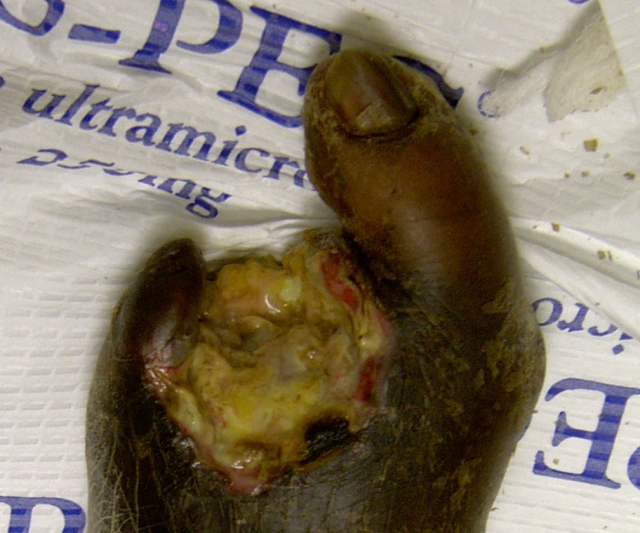Gangrene classification: Difference between revisions
| Line 12: | Line 12: | ||
{| style="border: 0px; font-size: 90%; margin: | {| style="border: 0px; font-size: 90%; margin: 1px; width: " align="center" 400px;" | ||
| valign="top" | | | valign="top" | | ||
|+<big>''' Table 1. Classification of [[Gangrene]].'''</big> | |+<big>''' Table 1. Classification of [[Gangrene]].'''</big> | ||
Revision as of 08:16, 2 April 2022
|
Gangrene Microchapters |
|
Diagnosis |
|---|
|
Treatment |
|
Case Studies |
|
Gangrene classification On the Web |
|
American Roentgen Ray Society Images of Gangrene classification |
|
Risk calculators and risk factors for Gangrene classification |
Editor-In-Chief: C. Michael Gibson, M.S., M.D. [1]Associate Editor(s)-in-Chief: Edzel Lorraine Co, D.M.D., M.D.
Overview
There are three main types of gangrene which include wet, dry, and gas gangrene. Sometimes, gangrene is also classified according to its site. [1]
Classification
There are three main types of gangrene which include wet, dry, and gas gangrene. Sometimes, gangrene is also classified according to its site. Table 1 summarizes the classification of gangrene.[1]
| Classification | Example | Description | Images |
|---|---|---|---|
| Based on Type | Dry Gangrene | Dry gangrene refers to a dehydrated necrotic tissue brought about by worsening ischemia distal to the occlusion of arteries. This is usually a worsening condition of peripheral artery disease.[2] |
|
| Wet Gangrene | |||
| Gas Gangrene | Gas gangrene is a bacterial infection that produces gas within tissues. It is a deadly form of gangrene usually caused by Clostridium perfringens bacteria. Infection spreads rapidly as the gases produced by bacteria expand and infiltrate healthy tissue in the vicinity. Because of its ability to quickly spread to surrounding tissues, gas gangrene should be treated as a medical emergency.
|
||
| Based on Site | Gangrene of the skull | ||
| Gangrene of the face | Noma is the term used to refer to the gangrene of the face. | ||
| Gangrene of the jaw | |||
| Gangrene of the extremities | |||
| Gangrene of the ribs | |||
| Gangrene of the skin | Necrotizing fasciitis affects the deeper layers of the skin. | ||
| Gangrene of the genitals | Fournier gangrene usually affects the male genitals. |
